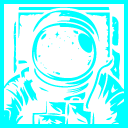
On January 31, 1971, Apollo 14 lifted off from the Kennedy Space Center in Florida. This was the first Apollo mission to the Moon since the failure of the Apollo 13 mission in April of 1970. While the crew of Apollo 13 did make it back to Earth alive, they were unable to complete their landing near the Fra Mauro Crater. Nine months later, Apollo 14 would try again. The landing site would again be the Fra Mauro Formation near Cone Crater, with the primary objective of sampling material excavated by impact events.


The crew of Apollo 14 consisted of one veteran astronaut and two rookies making their first flight. The mission commander was Alan B. Shepard Jr., one of the original Mercury Seven astronauts. He became the first American to enter space with a suborbital flight on May 5, 1961. At age 47, he was the oldest of the Apollo astronauts to walk on the Moon. The Command Module Pilot was Stuart A. Roosa. Roosa worked for the U.S. Forest Service in the early 1950’s as a smoke jumper helping fight fires. He later joined the U.S. Air Force, becoming a test pilot. The Lunar Module Pilot was Edgar D. Mitchell. Mitchell was a Naval Aviator and test pilot. During the Apollo 13 crisis, Mitchell was part of the Apollo 13 Mission Operations Team that helped bring the crew back safely.


The callsign for the Command Module was Kitty Hawk and the Lunar Module was called Antares. One unusual aspect of the mission were the difficulties experienced in the first docking of Kitty Hawk with Antares. Six attempts were required before a “hard dock” was achieved. An in-flight televised inspection of the docking mechanism revealed no apparent reason for the malfunction and the system appeared to be functioning normally.
Another problem arose later in the mission with the Lunar Module computer. Prior to the powered descent initiation, or PDI, a short in the computer abort switch was discovered. This short could have triggered an undesired abort during the Antares descent. Fortunately, with help from mission control, the astronauts were able to program a software fix before firing the engine for landing.
Apollo 14 landed on February 5, 1971, with astronauts Shepard and Mitchell becoming the 5th and 6th humans to walk on the lunar surface. Commander Shepard was the first astronaut on the Moon to wear a space suit with red commander’s stripes on the arms, legs, and helmet. This change came about because with their gold helmet visors down, it was hard to tell which astronaut was which in photographs and television transmissions.


During their time on the Moon, Shepard and Mitchell conducted two extra vehicular activities, or EVAs on the lunar surface. The first EVA lasted four hours, 49 minutes and the second EVA lasted four hours, 35 minutes. During the two traverses, the astronauts set up experiment equipment and collected 94 pounds of lunar rocks and soil for return to Earth.
Before departing the Moon, Commander Shepard made history by becoming the first, and so far, only, person to hit a golf ball on the Moon. On February 6, he attached a specially modified 6-iron golf club head to the foldable shaft of a lunar soil sampler and hit two golf balls out into the lunar terrain. Shepard later donated the 6-iron to the U.S. Golf Association Museum in 1974.

After a nine day mission, Apollo 14 splashed down in the Pacific Ocean on February 9, 1971. The success of the Apollo 14 mission after the near tragedy of Apollo 13, paved the way for the Apollo program to continue with the final three missions, 15, 16 and 17.



